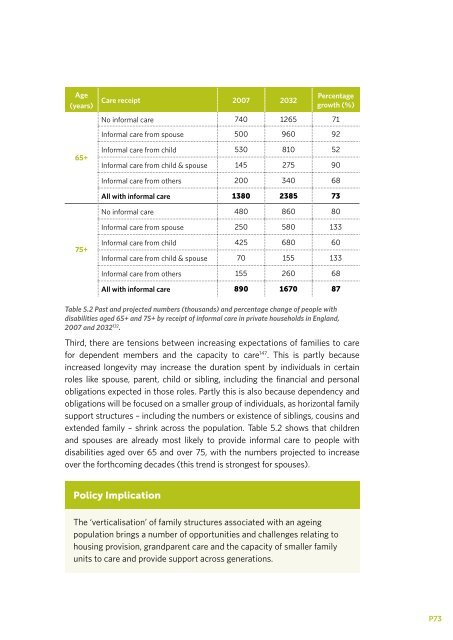Future of an Ageing Population
gs-16-10-future-of-an-ageing-population
gs-16-10-future-of-an-ageing-population
Create successful ePaper yourself
Turn your PDF publications into a flip-book with our unique Google optimized e-Paper software.
Age<br />
(years)<br />
65+<br />
Care receipt 2007 2032<br />
Percentage<br />
growth (%)<br />
No informal care 740 1265 71<br />
Informal care from spouse 500 960 92<br />
Informal care from child 530 810 52<br />
Informal care from child & spouse 145 275 90<br />
Informal care from others 200 340 68<br />
All with informal care 1380 2385 73<br />
No informal care 480 860 80<br />
Informal care from spouse 250 580 133<br />
75+<br />
Informal care from child 425 680 60<br />
Informal care from child & spouse 70 155 133<br />
Informal care from others 155 260 68<br />
All with informal care 890 1670 87<br />
Table 5.2 Past <strong>an</strong>d projected numbers (thous<strong>an</strong>ds) <strong>an</strong>d percentage ch<strong>an</strong>ge <strong>of</strong> people with<br />
disabilities aged 65+ <strong>an</strong>d 75+ by receipt <strong>of</strong> informal care in private households in Engl<strong>an</strong>d,<br />
2007 <strong>an</strong>d 2032 132 .<br />
Third, there are tensions between increasing expectations <strong>of</strong> families to care<br />
for dependent members <strong>an</strong>d the capacity to care 147 . This is partly because<br />
increased longevity may increase the duration spent by individuals in certain<br />
roles like spouse, parent, child or sibling, including the fin<strong>an</strong>cial <strong>an</strong>d personal<br />
obligations expected in those roles. Partly this is also because dependency <strong>an</strong>d<br />
obligations will be focused on a smaller group <strong>of</strong> individuals, as horizontal family<br />
support structures – including the numbers or existence <strong>of</strong> siblings, cousins <strong>an</strong>d<br />
extended family – shrink across the population. Table 5.2 shows that children<br />
<strong>an</strong>d spouses are already most likely to provide informal care to people with<br />
disabilities aged over 65 <strong>an</strong>d over 75, with the numbers projected to increase<br />
over the forthcoming decades (this trend is strongest for spouses).<br />
Policy Implication<br />
The ‘verticalisation’ <strong>of</strong> family structures associated with <strong>an</strong> ageing<br />
population brings a number <strong>of</strong> opportunities <strong>an</strong>d challenges relating to<br />
housing provision, gr<strong>an</strong>dparent care <strong>an</strong>d the capacity <strong>of</strong> smaller family<br />
units to care <strong>an</strong>d provide support across generations.<br />
P73


